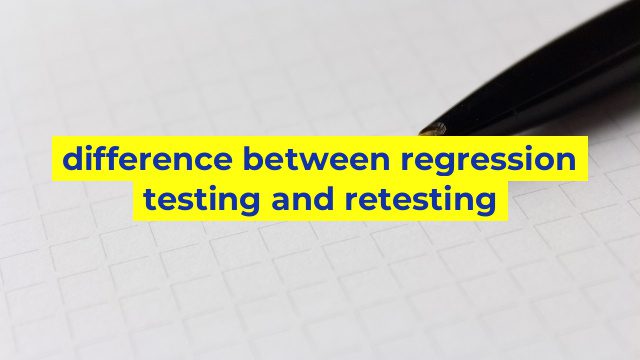Differences between Regression Testing and Retesting
What is Regression Testing?
Regression testing is a software testing process that is performed to verify whether the changes or modifications made to the software have not affected its existing functionality. It involves running the entire test suite to ensure that the new changes have not introduced any previously resolved bugs or defects in the software. Regression testing is usually performed after every change or modification in the software.
What is Retesting?
Retesting is a software testing process that is performed to verify if a defect or bug has been fixed in the software. It involves running the tests related to the failed test cases to ensure that the issue has been resolved and the software is functioning as expected. Retesting is usually performed after a bug has been reported and fixed.
The Differences
The main differences between regression testing and retesting are as follows:
1. Purpose:
Regression testing is performed to ensure that the existing functionality of the software is not affected by the changes or modifications made to it.
Retesting is performed to verify if a previously reported bug or defect has been fixed in the software.
2. Timing:
Regression testing is usually performed after every change or modification in the software.
Retesting is usually performed after a bug or defect has been reported and fixed.
3. Scope:
Regression testing involves running the entire test suite to ensure that the new changes have not introduced any previously resolved bugs or defects in the software.
Retesting involves running only the failed test cases to ensure that the issue has been resolved and the software is functioning as expected.
4. Process:
Regression testing is a continuous process that is performed throughout the software development life cycle.
Retesting is performed only when a bug or defect is reported and fixed.
Conclusion
Regression testing and retesting are both important software testing processes and serve different purposes. Regression testing ensures that the existing functionality of the software is not affected by changes or modifications made to it, while retesting verifies if a previously reported bug or defect has been fixed. By understanding the differences between these processes, software testers can perform them more efficiently and effectively to ensure high-quality software.
Table difference between regression testing and retesting
| Regression Testing | Retesting |
|---|---|
| Regression testing is performed on the modified software product to ensure that no new bugs have been introduced and previously fixed bugs have not reappeared. | Retesting is performed on the modified software product to ensure that the bugs identified during the previous round of testing have been fixed and the product is now working correctly. |
| It is performed after making changes or adding new features to a software product. | It is performed after fixing a bug or defect in the software product. |
| Regression testing ensures that the new changes have not affected the previously tested areas of the software product. | Retesting ensures that the bug or defect has been fixed and no other errors have been introduced as a result. |
| It is a type of testing that is typically performed after completion of functional and non-functional testing. | It is a type of testing that is typically performed after a bug or defect has been fixed. |
| Regression testing focuses on testing the entire software product to ensure the changes made have not had any unintended side effects. | Retesting focuses on testing the specific feature or function that was previously not working correctly to confirm that it is now functioning as expected. |

